Live on the homepage now!
Reader Supported News
Joe Manchin of West Virginia and Kyrsten Sinema of Arizona appear to relish the power they wield over the rest of the party. They are, in effect, holding the president’s priorities hostage to their personal whims. That’s not a new story in politics. But their stubbornness in the face of contemporary challenges reveals the bottomless emptiness of their brand of centrist politics.
Manchin and Sinema say they are worried about the money, so much so that Manchin has called for a “strategic pause” on the bill. “I, for one, won’t support a $3.5 trillion bill, or anywhere near that level of additional spending, without greater clarity about why Congress chooses to ignore the serious effects inflation and debt have on existing government programs,” he wrote in an op-ed for The Wall Street Journal. As countless wonks have pointed out, however, the bill is largely paid for and should have minimal effect on inflation and the national debt.
Though it has been reported that she is against the tax hikes in the bill, Sinema, as is her wont, appears reluctant to explain her motivations to the public. In ongoing one-on-one negotiations with Biden himself, she has reportedly refused to name a price tag that is acceptable to her. If there is any genuine policy thinking at all behind her recalcitrance, it has yet to emerge.
News that she is about to raise money from business interests that oppose the budget bill has invited speculation that she is doing her donors’ bidding. Meanwhile, the budget’s climate provisions disturb Manchin, who makes a sizable profit from the coal industry. Perhaps plain old corruption is at work here.
But there is more to it than that. Everyone involved in this saga, from President Biden down, is making a moral choice. The president’s budget is, like all presidential budgets, a public expression of the administration’s values. Sinema and Manchin have also expressed their values in public, even though these are cloaked in boilerplate rhetoric about inflation and taxes. Sinema’s donors are a reflection of her personal priorities. The same is true for Manchin when it comes to the profit motive. They’ve chosen their benefactors, not their voters, as their real constituency.
The Build Back Better plan is broadly popular with the American public, Data for Progress reports. Certain provisions, like the budget’s investment in home care, are even more popular than the overall plan, evidence that voters want something more robust than a highway bill. The popularity of the president’s agenda strikes down a key claim put forward, often by moderate Democrats and their defenders: that they’re limited by what their red-state voters want.
It’s obvious that Manchin and Sinema are doing what they want to do, not what their voters want. Nor are they motivated by what their voters need — a slightly different question that is nevertheless highly relevant to the fate of the Biden budget.
The planet is warming, whether Joe Manchin wants to admit it or not. The rampant inequality exposed by COVID can only be solved through greater public spending. If the Democratic Party wants to guarantee a livable future for the public, it is going to have to act while it can. Through their intransigence, these two moderates haven’t just jeopardized what might be Biden’s signature policy achievement. They’ve done more than undermine their party’s electoral future (why should voters support a party that wasted the power they gave it?). They are sacrificing the future itself.
And for what? Manchin is genuinely vulnerable to a challenge from the right in a deep-red state, but Sinema is not. In fact, she has practically guaranteed herself a primary challenge that she’s poorly positioned to win. The Sinema and Manchin school of politics defies reality, and common sense along with it. It has never been more apparent that the real threat to the president is not the left — which has emerged as the strongest defender of the Biden agenda — but the centrists. They have no vision. Asked, repeatedly, by the president, their colleagues, and nearly everyone else what it would take for them to support the spending package in question, they have little to say.
That’s a telling silence. Some version of the bill may well pass, but these tortured negotiations have exposed the barrenness of their position. Sinema and Manchin have a way of doing politics that redounds to no one else’s benefit, and sometimes not even themselves. They are risking Biden’s legacy, the prospects of their party, and the well-being of the American public for reasons they can’t even articulate. If only they were capable of shame.
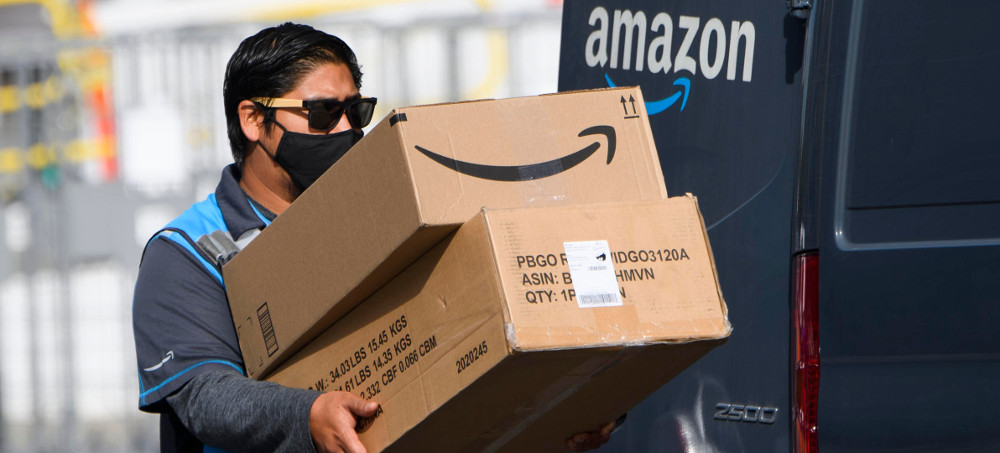 Organizing a militant rank-and-file-led union at Amazon could be the strategic key to revitalizing the labor movement. (photo: Getty)
Organizing a militant rank-and-file-led union at Amazon could be the strategic key to revitalizing the labor movement. (photo: Getty)
ALSO SEE: Wave of US Labor Unrest Could See Tens of Thousands on Strike Within Weeks
Failing to unionize Amazon would hasten the US labor movement’s decline. But that doesn’t have to happen. We have a fleeting opportunity to organize Amazon — if labor and the Left make it an urgent priority.
Socialists and labor movement activists should support Amazon worker organizing on the basis of these cruel and unjust working conditions alone. But we should also focus on Amazon for another, equally important reason: organizing a militant rank-and-file-led union at Amazon may be the strategic key to revitalizing the labor movement, while failing to do so could dramatically accelerate the movement’s decline. Fortunately, efforts are underway to develop militant, rank-and-file-led unionism at Amazon that left activists can and should support.
Regulating Capital in the Logistics Chain Gang
Amazon plays a special role in the twenty-first-century US economy, which should make it a top priority for labor movement organizers hoping to improve the conditions of labor in the country as a whole. The company is located at the heart of the nation’s for-profit logistics sector, which has developed a unique significance in US supply chains over the last fifty years.
As US industry was restructured in the 1970s and 1980s, and millions of workers were displaced from manufacturing through automation, offshoring, and just-in-time production methods, the labor movement suffered many defeats, from the rise of concessionary contracts to the severe decline of union density overall. This decline owed partly to a successful employer offensive, but it was also bolstered by stagnating employment in manufacturing (even as output soared), which made it easier for employers to wring out concessions.
Yet throughout this period, and continuing into recent years, logistics has grown to employ a massive 5.8 million workers. Unlike other sectors that can be automated and offshored, logistics is labor intensive, geographically rooted, and fortified by the lengthening of supply chains and the global integration of markets.
The logistics industry was also centralized over this period as employers implemented lean production methods, which squeeze more productivity out of fewer workers by reducing redundancies in the supply chain. Lean production led to the concentration of much of the United States’ economic flows into a series of logistical choke points, which act as hubs for the rest of the economy. Kim Moody describes these “nodes” in his book On New Terrain as being “enormous logistics clusters of transportation hubs, massive warehouses and distribution centers . . . that bring thousands of workers into finite geographic concentrations.”
Thus, while much of the labor force suffered from the disorganizing effects of layoffs and decentralization, logistics workers have by contrast grown increasingly concentrated and structurally powerful. Amazon exemplifies this unique concentration of logistics workers. A majority of workers in the United States work in shops with fewer than one thousand workers. Meanwhile, 25 percent of all workplaces in the US with one thousand or more workers are Amazon workplaces.
While the union density and job conditions in logistics have declined as elsewhere, there remain strong bastions of organized labor in the industry, particularly in the International Brotherhood of Teamsters (IBT), whose 1.4 million members primarily work in this sector. But despite its large membership, the IBT is at a crossroads. Amazon and other nonunion competitors have increasingly penetrated the industry, and the massive cost advantages a company like Amazon has will rapidly put pressure on unionized competitors like UPS.
For example, while a top-paid UPS driver makes around $40 an hour and has full family health care and a pension, most Amazon drivers make less than $20 dollars an hour, with limited (if any) health care and no pension. Amazon warehouse workers likewise lack the health care and pension benefits that Teamsters enjoy, as well as the vacations, holidays, and scheduling perks enshrined in union contracts. How can UPS, whose 260,000 Teamster employees in the United States make up the largest plurality of IBT members, compete with such a low-cost behemoth? In the long run, it can’t.
For now, union employers like UPS enjoy the advantages of existing infrastructure and contracts, while Amazon has only just started to enter the shipping field. But these advantages are rapidly being eroded as Amazon pivots to vertical integration of its operations, building out its own shipping and delivery infrastructure rather than rely on other shipping companies. The massive amounts of cash generated by Amazon’s other fields of business, such as web services, facilitate this expansion. Since 2014, Amazon has invested $60 billion in shipping infrastructure alone, positioning it as the fourth-largest delivery company in the United States, with its market share rapidly increasing.
As Amazon builds out low-cost and high-volume shipping infrastructure, it will become what Anwar Shaikh calls a “regulating capital,” a company whose prices are determinative for a given market. Other companies have to match the prices regulating capitals set, even taking a cut in profits to do so if necessary. If they don’t, they’ll lose market share, and eventually go bankrupt.
But companies hate taking cuts in profits, and are only able to do so up to a point. Realistically, once companies like UPS begin to feel their profit margins shrinking in a few years under the competitive pressure of Amazon, they will fight like hell to wring out concessions in their labor contracts, putting the burden of this competition on an increasingly exploited workforce. In fact, UPS already secured some two-tier concessions in its last 2018 contract with the Teamsters, even without Amazon directly eating into its profits yet. The company has also started finding ways to work around its unionized labor force, such as using nonunion “private vehicle drivers” during peak season, and acquiring the gig delivery service company Roadie.
One can only imagine how UPS will dig in its feet in five or ten years from now, when competitive pressures pose an actual threat to profitability. We could see massive layoffs and givebacks, which would severely weaken the IBT and reduce the ability of militant tactics like strikes to win gains for workers. This will have a cascading effect, whereby workers will see less of the benefits of unionism, making new organizing drives harder and letting nonunion competitors expand even further.
A form of this anti-labor chain reaction occurred across the United States starting in the 1980s, continuing in many sectors to the present day. If something similar occurs in the logistics sector, the most strategically concentrated for-profit sector of the US economy, what remains of the labor movement will face immense pressures in its continuing decline throughout the rest of the economy.
However, while we should heed this grim potentiality, it is by no means foreordained. In fact, conditions for organizing Amazon, and achieving a revitalizing breakthrough for unionism, have never been better.
Stand Up, Fight Back
In June of this year, at the 30th International Convention of the Brotherhood of Teamsters, delegates overwhelmingly passed a resolution prioritizing Amazon organizing, creating and funding an Amazon organizing division to do so. The IBT has suggested that this organizing drive will focus on building rank-and-file power at Amazon on the shop floor, which it hopes will escalate toward area- and company-wide organizing drives — as opposed to the more top-down, NLRB-vote-focused approach other unions have hitherto taken with the company.
A militant, company-wide organizing effort echoing the CIO organizing drives and recognition strikes of the 1930s would serve as a clarion call to the rest of the labor movement that it’s once again time to organize or perish. In the best-case scenario, it could catalyze organizing efforts throughout the service, manufacturing, and logistics industries, which make up the unorganized core of the US economy. The parallel timing of such an organizing drive with UPS contract negotiations in 2023, which could very well lead to the first national UPS strike in over twenty years, could spark a new era of labor organizing in the twenty-first century.
In order to be successful, this endeavor will require a lot more than millions of dollars and staff organizers. First and foremost, it will take a network of dedicated organizers building collective power on the shop floor. The Teamsters’ organizing plan is centered around such an approach. In fact, the Teamsters’ national director of Amazon organizing, Randy Korgan, has explicitly stated that the Teamsters will be mobilizing the existing interpersonal relationships of their members as well as training rank-and-file Teamster workers to engage in worker-to-worker organizing in order to build power at Amazon.
In addition to the ambitious company-wide organizing efforts of the Teamsters, Amazon workers around the country are already organizing for better conditions in a variety of embryonic labor organizations, such as the Amazon Labor Union, Athena, and Amazonians United. The latter group in particular has had success in building community and shop-floor committees which have already won real gains for Amazon workers.
From a walkout that shut down a Queens facility after a worker tested positive for COVID-19 to strikes in Chicago over twelve-hour megacycle shifts, workers with Amazonians United (AU) have organized a variety of impressive shop-floor actions around the country. They’re also winning. For example, AU workers in Sacramento successfully won the rehiring of two workers after they were unjustly fired for taking time off due to deaths in their families. Subsequently AU organizers around the country began a campaign for paid time off, which succeeded in pressuring Amazon to offer it nationally.
In addition to organizing shop-floor actions, AU tries to build a community of Amazon workers by hosting barbecues, publishing leaflets, and building social groups at Amazon warehouses, which are otherwise notorious for their social disorganization and worker isolation (by Amazon’s design). These slow, cellular aspects of organizing will be crucial in forming a conscious, organized, and militant layer of workers at Amazon ready to take on the boss in the long run.
The New Militant Minority
While Amazonians United organizers have made great strides building power on the shop floor, we will need hundreds more disciplined and inspired organizers to take on Amazon across the country.
As Peter Olney and Rand Wilson have argued, one key element in this militant minority of shop-floor activists and leaders will be “salts,” or workers who get a job with the intention of organizing. Democratic socialists, who understand that the viability of the socialist project is built on the organized strength and capacity of the working class to fight for its interests through the labor movement, are precisely the type of people who should be willing to get jobs at Amazon to help build a union.
Fortunately, the Democratic Socialists of America (DSA) recently passed a resolution at its national convention declaring support for Amazon organizing. As Teamster trucker Ryan Haney has argued, if DSA can rally even a small fraction of its nearly one hundred thousand members toward the goal of organizing Amazon, it could have a significant impact, as many of these members have experience in the basics of organizing from other social-movement work. Moreover, with dozens of elected politicians throughout the country, as well as dedicated offices and staffers, DSA chapters have significant political and social resources they could direct toward Amazon organizing efforts in creative ways.
Historically, the labor movement has been built and led by an organized militant minority of rank-and-file progressives who have had the discipline and vision required to make organizing breakthroughs. From the socialist Reuther brothers, who led the sit-down strikes of 1936–37 and built the United Auto Workers (UAW), to the Trotskyist Teamsters, who led the 1934 Minneapolis general strike, to the red longshoremen, who built the International Longshore and Warehouse Union (ILWU), almost every major breakthrough in the labor movement has had disciplined activists from the organized left at its forefront. DSA members should take up the mantle by supporting — and, better yet, becoming — Amazon workers.
There is no doubt that we face an uphill battle at Amazon, with high turnover, subcontracted delivery-driver operations, and a variety of disparate labor organizations working in relative isolation against a multibillion-dollar behemoth. But so too did William Z. Foster and other early left industrial unionists one hundred years ago, while contending with their own fragmented craft unions and their own novel and brutal industrial conditions.
Just as Foster and others proved the ubiquitous naysayers of their era wrong by weaving together dozens of craft unions and leading the first national industrial organizing drives in steel and meatpacking, we too must see these barriers as problems to be solved by creative forms of organizing. Only by building a united front between DSA, the Teamsters, Amazonians United, and other labor groups, and by mobilizing all the resources at our collective disposal, will we stand a chance of organizing Amazon before it’s too late.
To turn this possibility into a reality, the Left must make organizing Amazon its number-one labor priority. To do otherwise is to forfeit the historic responsibility we have to rebuild the union movement, merge it with the movement for democratic socialism, and build a Left that can win.
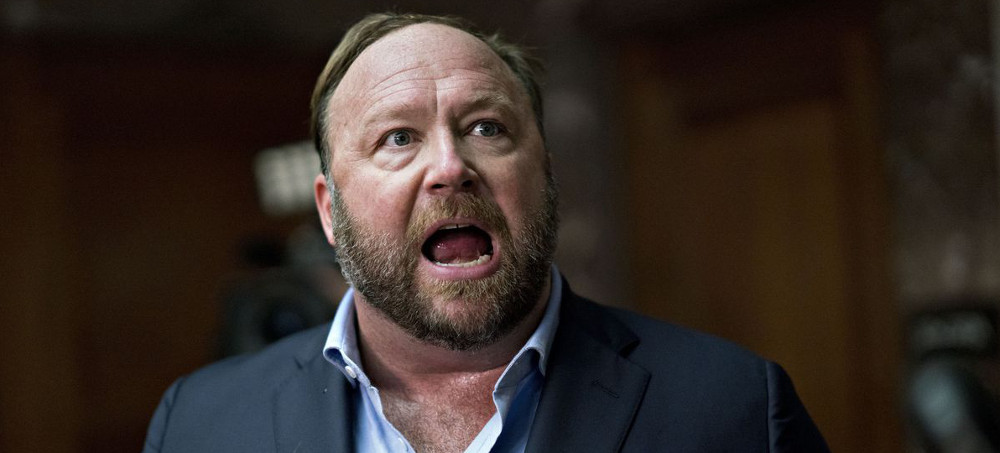 Alex Jones, radio host and creator of the website InfoWars, speaks to members of the media in Washington, D.C., Sept. 5, 2018. (photo: Andrew Harrer/Bloomberg)
Alex Jones, radio host and creator of the website InfoWars, speaks to members of the media in Washington, D.C., Sept. 5, 2018. (photo: Andrew Harrer/Bloomberg)
Jury will now consider damages after far-right conspiracy theorist failed to produce documents for the court cases
The rulings are “default judgments”, or rare de facto losses, because of Jones’s repeated failure to comply with discovery, or the process of producing documents for a court case. The court will convene a jury to consider damages.
“The court finds that defendants’ failure to comply … is greatly aggravated by [their] consistent pattern of discovery abuse throughout similar cases pending before this court,” wrote the Texas judge, Maya Guerra Gamble, in a judgment reported by CNN.
“The court finds that defendants’ discovery conduct in this case is the result of flagrant bad faith and callous disregard for the responsibilities of discovery under the rule,” she wrote.
In 2012, a shooter with an AR-15-style rifle entered Sandy Hook elementary school and shot and killed 26 people, including six educators and 20 small children in Newtown, Connecticut.
In the years that followed, families would be plagued by death threats and harassment, prompted by conspiracy theories that the shooting was staged – with Jones among the most high-profile promoters of such baseless claims.
In just one example, Jones would tell listeners in 2014, “The whole thing was fake.” He continued, “It just pretty much didn’t happen”. The subjects of such lies, such as the Sandy Hook parent Lenny Pozner, were in some instances forced to move multiple times to dodge threats made by followers of conspiracy theorists such as Jones.
In one instance, a Florida woman was sentenced to jail after sending Pozner multiple death threats. As part of the ruling against her, she was barred from accessing the Infowars website, the Huffington Post reported.
The suits are among several brought by Sandy Hook families seeking to hold gunmakers and conspiracy theorists accountable.
In a separate case in 2020, Jones was ordered to pay $100,000 to the family of a Sandy Hook shooting victim, after he failed to produce witnesses for the suit. In another case against conspiracy theorists, Pozner was awarded a $1.1m judgement against two men who authored a book called Nobody Died at Sandy Hook.
Sandy Hook families have also sued the gunmaker Remington. In July, the company offered $33m to settle the case, which alleges the gunmaker’s marketing campaign was meant to appeal to disturbed young men like the one who committed the massacre.
Despite his repeated claims, Jones said in a 2019 court deposition that he now believes, “Children died, and it’s a tragedy.”. However, in a statement posted to the Infowars website on the default judgments, Infowars’ tone was still defiant.
“The trial court’s entry of a default in these cases is stunning,” said Infowars’ attorney, Norm Pattis, in an article which described the decision as from a “Democrat judge” and “100% unconstitutional”.
“It takes no account of the tens of thousands of documents produced by the defendants, the hours spent sitting for depositions and the various sworn statements filed in these cases.”
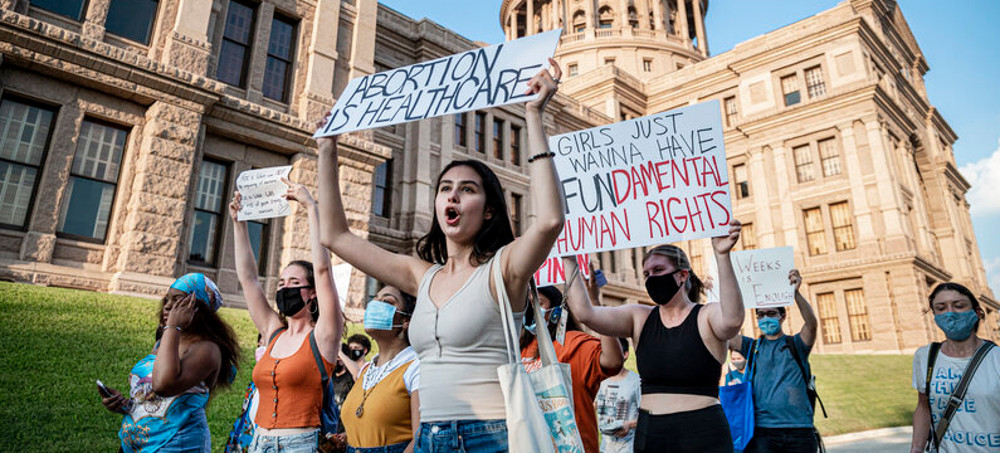 Pro-choice protesters march outside the Texas State Capitol, Sept. 1, 2021, in Austin. (photo: Sergio Flores/Getty)
Pro-choice protesters march outside the Texas State Capitol, Sept. 1, 2021, in Austin. (photo: Sergio Flores/Getty)
Department attorneys and lawyers for the state of Texas made their case on Friday at a virtual hearing before Judge Robert Pitman of the U.S. District Court for the Western District of Texas. At stake is the ability of women in the country's second largest state to pursue abortions after about six weeks of pregnancy, a time when many people don't realize they're pregnant.
"The state resorted to an unprecedented scheme of vigilante justice that was designed to scare abortion providers," argued Brian Netter, a lawyer for the Justice Department. "So far, it's working. Women have been left desperate, forced under sometimes harrowing circumstances to get out of Texas, if they even can."
In response, Texas lawyer Will Thompson replied, "I'm sorry to see that the federal government's pattern of hyperbole and inflammatory rhetoric has continued." Thompson described the new law and its design as "normal and lawful."
The hearing comes less than a month after the Justice Department sued Texas over the new abortion law known as S.B. 8. The department says the law is unconstitutional and violates the Supremacy Clause as well as the equal protection afforded under the 14th amendment.
The new Texas law, which took effect Sept. 1, contains no exceptions for cases of rape, sexual abuse and incest.
And it includes a novel enforcement mechanism: it allows private citizens to bring civil suits against anyone who helps a woman get an abortion, and to collect $10,000 in damages if they prevail in court.
In its lawsuit, the Justice Department said the bill's enforcement scheme is an unconstitutional attempt to sidestep judicial review and prevent women and providers from challenging the law in federal court.
Attorney General Merrick Garland warned when he announced the lawsuit that the Texas bill and its enforcement mechanism, if allowed to stand, could provide a model for other states to pass a similar law to restrict abortion or other constitutionally protected rights.
Texas has asked the judge to be specific if he decides to block the law
The Justice Department argued the law already has had "devastating effects," saying it has "has gravely and irreparably impaired women's ability to exercise their constitutional right to an abortion across the state."
It said some women have had to travel hundreds — sometimes thousands — of miles to neighboring states in order to terminate their pregnancy.
"One minor, who was raped by a family member, traveled eight hours from Galveston to Oklahoma to get an abortion," the department said in its filing.
It has also had an impact on the rights of women in other states, such as Oklahoma, Kansas, Colorado, Nevada and New Mexico, where Texas patients are frantically trying to get appointments, the department's filing said.
Texas has been urging the court to deny the federal government's motion and dismiss the case. Thompson, of the state attorney general's office, has asked the judge to be specific if he decides to block the law. Texas has signaled it wants to quickly seek appellate review if it loses in the lower court.
In its court papers, the state argued that the Justice Department hadn't met the legal threshold to warrant an emergency injunction and, more fundamentally, the state argued that the law is constitutional.
"The federal government has not clearly shown that the Texas Heartbeat Act is unconstitutional, that a preliminary injunction would remedy irreparable harm, or that the balance of equities and public interest favor extraordinary relief," the state said in its filing.
It also said the entire suit lacked merit because state authorities aren't the ones enforcing the new law since that falls on private citizens.
"The fact that private parties may rely on the challenged statute in other litigation does not create a case or controversy against the sovereign," Texas wrote. "It simply shows that those other cases would be the proper cases for deciding the constitutionality of the challenged statute."
So far, one abortion provider has come forward to say he performed the procedure after the Texas law took effect. He's been sued by several individuals, including Oscar Stilley, a disbarred attorney previously convicted of tax evasion, who made an appearance at the hearing Friday.
The judge offered no time table for a decision
Judge Pitman, who was nominated to the bench by former President Obama, largely allowed the lawyers wide leeway to argue Friday, interrupting only a few times with questions.
To the Justice Department, the judge asked about any possible limits to the broad authority the federal government is claiming to sue the state. To Texas, Pitman wondered, "If the state's so confident" about the constitutionality of the limits on women's access to abortion, "why did it go to such great lengths" to fashion a private right to sue?
The judge thanked both sides and said he would take the issues under advisement. He offered no time table for a decision.
"We will get to work on the appropriate order in this case," Pitman said. "Have a great rest of the day and weekend."
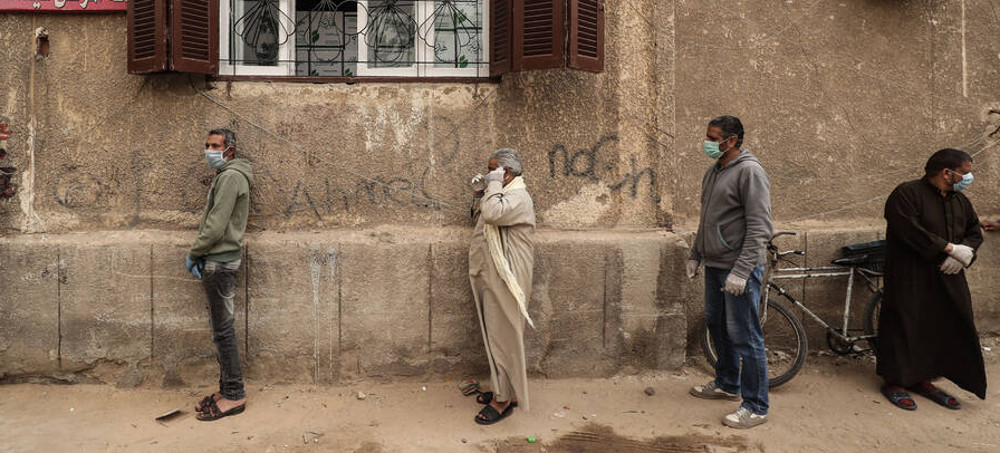 Egyptian men wearing masks wait outside a centre of non-governmental organization Egyptian Food Bank to receive cartons with foodstuffs on April 05, 2020. (photo: Mohamed el-Shahed/Getty)
Egyptian men wearing masks wait outside a centre of non-governmental organization Egyptian Food Bank to receive cartons with foodstuffs on April 05, 2020. (photo: Mohamed el-Shahed/Getty)
Little-known “surcharges” are adding to cash-strapped countries’ mountains of IMF debt.
But on top of the debt principal itself, and the interest rates countries must pay on that principal, there is a lesser-known — yet deeply pernicious — cost that is tacked on for those countries most in need: surcharges.
Surcharges are extra fees that are imposed on borrowing countries on top of all the other costs, ostensibly to incentivize countries to pay back their debts more quickly, and to protect the finances of the IMF. But according to a new report from the Center for Economic and Policy Research (CEPR), a left-leaning think tank, these fees are predatory and punishing, imposing devastating costs on countries that — by definition — are most desperate for funds.
The IMF began implementing surcharges in 1997 in response to the Asian Financial Crisis. Introduced with the creation of the Supplemental Reserve Facility (SRF), surcharges are supposed to incentivize countries to pay off their debts by heaping charges on them them for taking a long time to do so (more than four years), or borrowing over a certain amount (greater than 187.5 percent of their quota, which is the money countries pay to be part of the IMF). In other words, countries face surcharges for taking a long time to pay back loans, or for borrowing large sums — both indications that those countries are desperately in need of funds.
But since the late 1990s, surcharges have become standard across the institution. Beginning in 2009, surcharges have been applied to countries borrowing from the General Resources Account (GRA), the main account of the IMF. Andrés Arauz, economist at CEPR and co-author of the report, tells In These Times, “About 16 countries are currently paying surcharges on the basis of the size of their borrowing from the Fund.”
Yet, the report finds, there is no evidence that the surcharges accomplish the IMF’s stated goal of encouraging countries to pay off the IMF debt and return to private markets. After all, if countries had the ability to borrow from private markets, they wouldn’t be at the IMF in the first place.
Furthermore, there are already a number of other punishing “incentives” for rapid repayment. “IMF programs often come with onerous conditionality, requiring governments to enact unpopular reforms or to limit public spending, and so encouraging governments to seek exit as soon as they are able,” the report states.
Most importantly, some countries simply don’t have the money. “Of the few countries that have made early repayments, most of the repayers since 2009 are high-income European countries that have support from European Union institutions,” a report summary notes.
Instead, surcharges simply add to the crushing debts of borrowing countries, paradoxically imposing the most harm on the countries that have the greatest need. It’s the moral equivalent of a loan shark who increases the interest payments for people who have trouble paying and have no place else to go.
Due to a lack of transparency, the exact surcharges are unknown. But CEPR estimates that for the five largest current borrowers from the fund — Argentina, Ecuador, Egypt, Pakistan and Ukraine — surcharges comprise 45 percent of all non-principal debt service (interest, for example, would be another form of non-principal debt service). This comes to a stunning $2.7 billion in 2022 alone just from the combined surcharges for these five countries.
To understand the stakes, it’s worth taking a closer look at the most debt-saddled countries of the group. “Argentina will end up spending U.S. $3.3 billion in surcharges over the course of six years (2018 – 2023),” the report states. “This is nine times the amount it would have to spend to fully vaccinate every Argentine against Covid-19.”
The figures for Egypt are similarly stark. “Egypt will have spent U.S. $1.8 billion on surcharges between 2019 and 2024. This is three times the U.S. $602 million it would cost to fully vaccinate all Egyptians.”
The IMF says that the surcharges are necessary to help it build up its equity capital, a position its spokesperson Gerry Rice doubled down on in a March 2021 press briefing when asked about the case of Argentina. “ [Surcharges] enable us to help our low-income members in particular, by strengthening our financial capacity,” he told reporters.
But CEPR says this claim is absurd: The surcharges represent a small and insignificant amount relative to other sources of the IMF’s funding. “Looking at the $1 trillion firepower figure cited by the IMF’s managing director amid the pandemic as an indication of the true availability of funds for lending, the IMF does not depend on revenue from surcharges,” the report states.
Yet surcharges are not trivial for the countries saddled with them. “Surcharges are hurting countries most in need,” Mark Weisbrot, an economist, co-director of CEPR, and co-author of the report, tells In These Times. “They are regressive. Those countries are going to have to cut some spending or imports that they really need. And you’re taking that from countries that are much more likely to be needing it much more desperately if they’re heavily in debt. It’s unfair, and it doesn’t serve any useful purpose.”
The existence of surcharges is particularly remarkable because of the incredible harm that foreign debt has caused around the world. According to the global advocacy organization Jubilee Debt Campaign, as of 2019, 64 lower-income countries were spending more for payments on external debts than on healthcare. This absurd global arrangement, in which countries that were harmed by colonialism now must borrow from an institution led by their former colonizers, is made all the more bleak when you consider that the IMF can simply impose surcharges on top of these staggering debts.
That these surcharges persist during a pandemic, when spending on public health is desperately needed, is unconscionable. As the CEPR report puts it, “surcharges are inappropriate and unjustifiable, particularly during a pandemic combined with a very uneven recovery from a pandemic-driven world recession.”
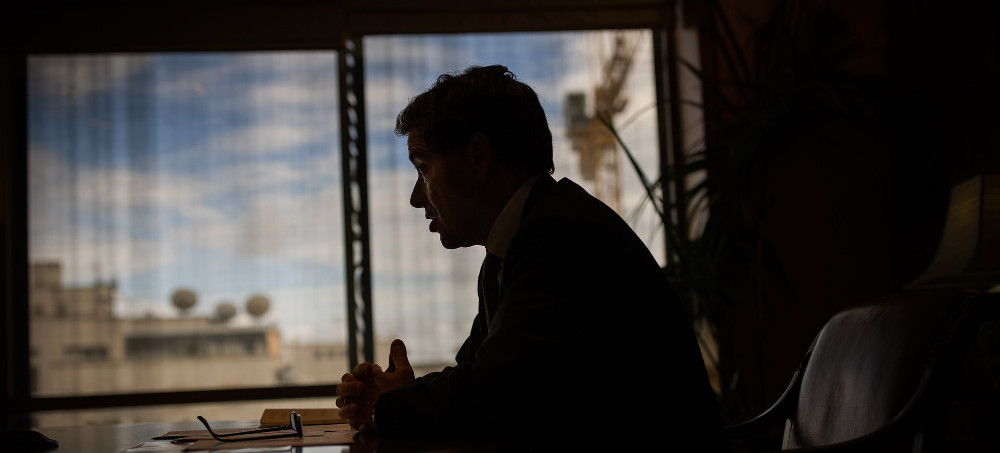 Antonio Ramalho, chief executive officer of Novo Banco SA, speaks during an interview at the bank's headquarters in Lisbon, Portugal, Sept. 23, 2020. (photo: Jose Sarmento/Getty)
Antonio Ramalho, chief executive officer of Novo Banco SA, speaks during an interview at the bank's headquarters in Lisbon, Portugal, Sept. 23, 2020. (photo: Jose Sarmento/Getty)
One of Portugal’s largest banks is holding up a $12.7 million order to fund shipment of medical supplies and vaccines to Venezuela.
When faced with criticism over its sweeping sanctions against Venezuela, the U.S. government often points to the broad humanitarian exemptions in place, which it says allow for the free flow of food and medicines to those in need. But as the ongoing dispute over medical shipments illustrates, that’s not always the case.
According to documents shared with The Intercept, the Lisbon-based Novo Banco has for several weeks declined to approve a transfer from a Portuguese lender to the Pan American Health Organization, or PAHO, a public health agency affiliated with the World Health Organization.
Novo Banco did not respond to a request for comment. But according to critics within European Parliament, the stalled transaction is evidence of both the extensive reach and adverse effects of U.S. sanctions against Venezuela. Tightened under the Trump administration and left in place by President Joe Biden, these restrictions weigh heavily on banks and financial institutions — even those operating outside U.S. borders.
Novo Banco’s delay is part of a much larger conflict the bank has with the Venezuelan government. Starting in early 2019, after opposition lawmaker Juan Guaidó declared himself the country’s interim president and quickly earned recognition from the U.S. and the European Union, financial institutions across Europe froze assets belonging to the government of Nicolás Maduro or closely linked to it. These entities included Venezuela’s state-run oil company and its the public development bank, known as Bandes.
The sum includes roughly $1.7 billion at Novo Banco, a bank created in 2014 during Portugal’s most recent financial crisis. One quarter of the bank’s ownership belongs to Portugal’s Resolution Fund, a special state-backed fund to help stabilize banks. The other three quarters are owned by the American private equity firm Lone Star.
Though the EU has no longer recognized Guaidó as Venezuela’s president since January, the impasse has dragged on at Novo Banco. According to a July ruling from a Lisbon judge, the Portuguese lender is explicitly authorized to approve transactions from Bandes, so long as the transactions get approval from a judge beforehand. That’s precisely the process Venezuela’s development bank aimed to initiate this summer.
On July 22, Bandes requested approval from Novo Banco to send the roughly $12.7 million order to PAHO. To reduce fears of violating U.S. sanctions and maximize the chances of getting the green light from a judge, Bandes proposed conducting the transfer in Brazilian reais and depositing the money directly into a PAHO account based in Brasilia. It also included information about the medicine and supplies in question.
Two months later, however, Novo Banco has yet to give the thumbs-up. On September 15, Bandes President Héctor Andrés Obregón Pérez sent a follow-up letter to Novo Banco CEO Antonio Ramalho, urging him to move forward on the transaction, noting that the payment is “urgent” and for “humanitarian reasons.”
Now Novo Banco’s inaction is triggering criticism outside of Venezuela. A group of 24 European Parliament members plan to release a letter Thursday calling on the Portuguese lender to move ahead with the Venezuelan order for medicines. The letter, shared ahead of public release with The Intercept, argues that “there is no legal or extralegal obstacle that would preclude a Portuguese bank from making a transfer of Bandes’ own funds in Brazilian reais directly to a Brazilian bank account in order to pay for humanitarian supplies.”
The group also laments that “European banks continue to be over-compliant” with U.S. sanctions against Venezuela in spite of efforts “to clarify that humanitarian aid is perfectly permissible and even desirable.”
It’s a critique similar to the one made by the Progressive International, which earlier this year organized a conference highlighting the adverse effects of U.S. sanctions on public health — and in particular, the global fight against Covid-19.
“The case of Novo Banco makes it clear: sanctions kill,” James Schneider, communications director of the Progressive International, told The Intercept. “President Joe Biden and the G7 love to speak about the need for ‘solidarity’ in the face of a global pandemic. Yet their economic policies shut entire countries out of access to basic life-saving medicines and protect the profits of their pharmaceutical corporations ahead of the lives of everyday people dying of Covid-19 and other diseases.”
A spokesperson for the U.S. State Department declined to comment.
For its part, the Treasury Department’s Office of Foreign Assets Control — or OFAC, the agency that oversees enforcement of sanctions — maintains that various restrictions on doing business in Venezuela do not block civilians from accessing much-needed food and medicine. In August 2019, even after the Trump administration tightened sanctions as part of its so-called maximum pressure policy against Maduro, OFAC issued a guidance stressing that “the flow of humanitarian goods and services to the Venezuelan people is not prohibited by U.S. sanctions.”
Nevertheless, financial institutions sometimes go above and beyond what’s legally required, shying away from authorizing certain transactions out of an abundance of caution or fear of risking hefty penalties. As The Intercept reported earlier this year, for instance, the Venezuelan government blamed U.S. sanctions for hampering its ability to access Covid-19 vaccines through COVAX, the global vaccine-sharing initiative backed by the World Health Organization. (At the time, the State Department rejected the notion that it bore any responsibility.) In any case, Venezuela finally received its first shipment through COVAX this month. It was the last country in South America to get it.
Alena Douhan, the United Nations’ special rapporteur on unilateral coercive measures and human rights, has also drawn attention to the issue. In February, she issued a preliminary report on the effects of foreign sanctions on Venezuela, calling existing humanitarian exemptions “ineffective and inefficient” and arguing the “devastating effect” of sanctions is “multiplied by extra-territoriality and over-compliance.” Douhan has also specifically singled out Novo Banco: In July, she sent a letter to the bank alongside other U.N. officials in which they criticized the presence of “growing over-compliance, zero-risk policies” and reminded the Portuguese lender that EU member states are prohibited from complying with U.S. sanctions.
While debates rage over who bears responsibility, it’s clear the broader economic and public health picture in Venezuela remains bleak. More than 5 million people have fled the country in recent years, according to the U.N.’s High Commissioner for Refugees. According to the U.S. government’s own USAID agency, 7 million Venezuelans are in need of humanitarian assistance.
Thus far, the Biden administration has shunned calls to significantly change the Trump-era approach to Venezuela. In a joint statement issued in June alongside the EU and Canada, the U.S. has said it would consider easing sanctions on Venezuela if “meaningful progress” is made in talks between opposition figures and the government. This month, representatives from Guaidó and Maduro’s camps have held two rounds of negotiations in Mexico City mediated by Norway. As November’s regional elections approach, Maduro has applauded progress in talks, while a statement issued by Norway’s foreign ministry Monday said that the “two sides’ positions moved closer.”
 Greenpeace activists protest against greenwashing on May 12, 2021, in Rome, Italy. (photo: Simona Granati/Getty)
Greenpeace activists protest against greenwashing on May 12, 2021, in Rome, Italy. (photo: Simona Granati/Getty)
Apple, Amazon, Microsoft, and Disney are among the major corporations either supporting or actively directing lobbying groups like the U.S. Chamber of Commerce and Business Roundtable that are trying to kill the $3.5 trillion budget known as the Build Back Better Act (also known as the "reconciliation package").
"Major corporations love to tell us how committed they are to addressing the climate crisis and building a sustainable future," Kyle Herrig, president of watchdog group Accountable.US, which compiled the analysis, told The Guardian. "But behind closed doors, they are funding the very industry trade groups that are fighting tooth and nail to stop the biggest climate change bill ever."
Follow us on facebook and twitter!
PO Box 2043 / Citrus Heights, CA 95611

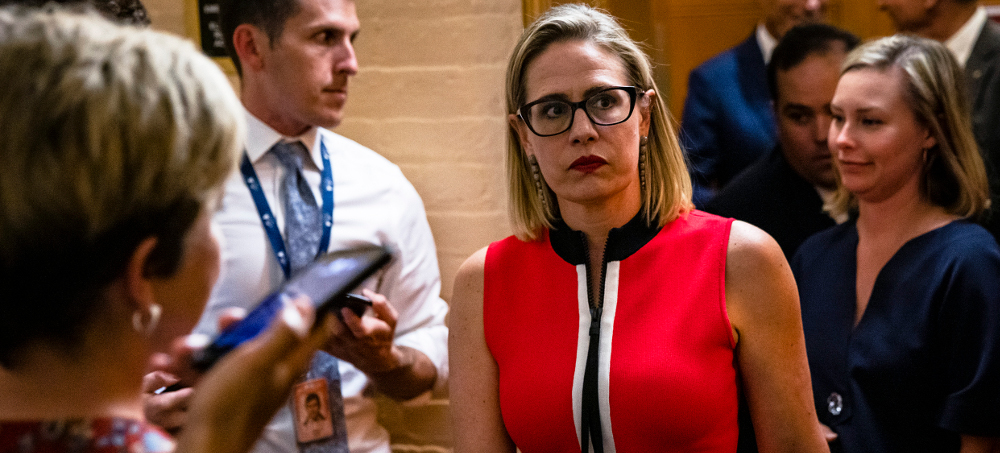

No comments:
Post a Comment